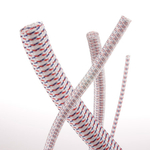What is a print media ad?
Print media advertising is a form of advertising that uses physically printed media to reach consumers, business customers and prospects. Print media ads were once the standard format for creative advertising. But as more and more advertising dollars are allocated to digital outlets, print media advertising is seen as an expensive, untrackable, traditional media format.
You would think the category is void of innovative ideas, but that’s certainly not the case. In fact, many brands are finding new ways to merge the digital and physical world through magazine and newspaper ads.
Here are 15 print media ads that should make you rethink the word “traditional.”
1) Glacial
If you’ve ever wanted to speed up the beer-cooling process, you’ll understand the allure of this print media ad from Glacial. You soak the ad in water, wrap it around the bottle, and put it in the freezer. The print media ad was made with salt particles, which reduce the freezing point of water.
2) Nivea
This print media ad won the Mobile Grand Prix at Cannes in 2014. The ad includes a wristband you could attach to your child as he runs around at the beach. The app lets you set a distance and receive alerts if the child wandered beyond the limit.
3) UTEC
UTEC, an engineering and technology university, wanted to recruit more students. Instead of placing the smiling faces of young graduates on a billboard, it created an ad that pulled moisture out of the air in Lima, Peru, which sees very little rain each year.
4) Motorola
The brand teamed up with Wired to promote the Moto X’s custimization. People could change the color of the phone by pushing buttons.
5) Kontor Records
Kontor Records wanted to get the attention of creative advertising professionals. Instead of mailing out the latest CD, it sent a vinyl record with a paper turntable that could be played with an iPhone.
6) Peugot
This print media ad for the car brand features a one-page ad with a front view of the car that asked people to hit the ad. The spread following it included a mini air bag that inflated when hit.
7) Lexus
In 2013, Lexus released an ad that, when placed over an iPad, revealed the car in action with different backgrounds and music.
8) Lladro Lighting
Why advertise lamps when you can give people an ad that transforms into a lamp? The print media ads act like a pop-up book, allowing people to create their own lamp shape by mounting the paper in a corner.
9) Ford
To show off the features of the Ford Explorer, the brand published three print media ads with interactive elements. The reader could scan a QR code and then line up the phone on the ad to see the car in action.
10) Volkswagon
Volkswagon published a three-page spread so readers could take a test drive. You could download an app and can try out different features, including the “Lane Assist” mode that would cause the phone to vibrate when it got too close to one side of the road.
11) Sonera
The telecommunications company highlighted its 4G wireless speed with a print media ad that served as the game board for an iPhone game.
12) C&A
Fashion retailer C&A published a print media ad in customized magazine editions that were linked to a person’s Facebook account. Readers could Like their favorite looks on Facebook by pressing the button in the ad. The data was then sent to a leaderboard in the store.
13) Nivea
To promote its sunscreen products, Nivea created a print media ad with a solar panel that could charge a cell phone.
14) Shikun & Binui Solaria
Israeli energy company launched this print media ad to promote green energy. The print media ad just seems like a simple black and white drawing. However, when you hold it up to sunlight, vibrant colors appear.
15) CW Network
The CW published this print media ad in Entertainment Weekly in 2012. The ad featured a LCD screen that is updated with videos from the network and a stream of live tweets.
This article comes from hubspot edit released

